![]()
![]()
![]()
Use LEFT and RIGHT arrow keys to navigate between flashcards;
Use UP and DOWN arrow keys to flip the card;
H to show hint;
A reads text to speech;
28 Cards in this Set
- Front
- Back
|
When do most congenital heart defects arise? |
Embryogenesis (first 3- 8 weeks of life) |
|
|
Name the 5 right-to-left shunts. |
1) Truncus Arteriosus 2) Transposition of the great vessels 3) Tricuspid Atresia 4) Tetrology of Fallot 5) Total Anomalous Pulmonary Venous Return |
|
|
How do Right-to-Left Shunts present? |
Early cyanosis, clubbing, polycythemia |
|
|
How do left-to-right shunts present? |
Initial causes RVH and pulmonary hypertension due to increase blood flow to pulmonary circulation, but as resistance increases in lungs, the RV pressure > LV causing a reversal shunt that causes late onset cyanosis (tardive) |
|
|
What is the most common congenital defect? What is the most common sub-type? Which sub-type will resolve on its own? |
VSD - Membranous is most common - Muscular resolves on its own |
|
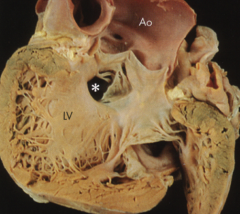
|
VSD |
|
|
Which sub-type of ASD is the most common? Which is associated with a cleft mitral valve? Which sub-type is seen in TAPVR? |
- Secundum - Primum - Sinus Venosus |
|
|
What is the difference between a patent foramen ovale and an ASD? |
Ovale is due to tissues not fusing. ASD is due to an absence of tissue. |
|
|
A 30 yr-old pt is complaining of pulmonary hypertension. Upon ausculation you hear a splitting of the S2 heart sound with A2 occuring before P2. |
ASD - most are asymptomatic until age 30 and have a split S2 due to late closure of pulmonic valve due to increased volume to right heart (left-to-right shunt) |
|
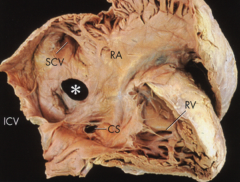
|
ASD |
|
|
**Describe the PDA murmer.** |
Best hear in the left infraclavicular space, sounds like a continuous machine that occurs through both systole and diastole |
|
|
How would you keep the PDA open to perfuse the lungs when a congenital defect prevents pulmonary flow? **What defect would this treatment not be used? |
Prostaglandin E -- Would not use for Truncus Arteriosus defect |
|
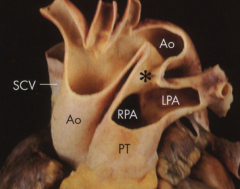
|
PDA |
|
|
What type of defect is comprised of a Primum ASD w/ a cleft ant. leaflet in mitral valve (ie a slit in ant leaflet)? What syndrome is seen in 1/3 of these pts? |
Partial Atrioventricular Septal Defect *Down's Syndrome* |
|
|
What type of defect is characterized by one common AV valve? |
Complete Atrioventricular Septal Defect |
|
|
*What are the 4 defects of Tetraology of Fallot?* |
1) Pulmonary outflow obstruction/stenosis 2) RVH 3) Overriding aorta (over vsd) 4) VSD (PROVe) |
|
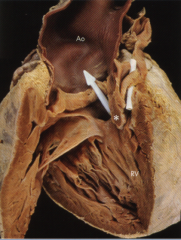
This baby developed cyanosis w/in minutes of birth. |
Tetrology of Fallot |
|
|
What defect causes/results in Tetrology of Fallot |
Anterio-Superior Displacement of the infundibular septum |
|
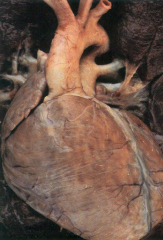
|
Transposition of the Great Vessels (notice how the aorta is front of the pulmonary trunk and the RVH and LV-atrophy) |
|
|
A baby is found to have a heart where the conotrouncal ridges fail to spiral and as a result is born with cyanosis. What drug should be given to the back to enable survival until a surgical fix can occur? |
Prostaglandin E to keep the PDA open |
|
|
What defect causes a right-to-left shunt, hypoplastic RV, and requires an ASD to survive? |
Tricuspid Atresia |
|
|
In what defect do no pulmonary veins drain into the left atrium due to a failure of the pulmonic vein to develop? How are the lungs venously drained in this condition? |
Total Anomalous Pulm. Venous Return (TAPVR) -- Drained via primitive systemic vein with a ASD or patent foramen ovale |
|
|
Where is the narrowing in a) Infantile Coarctation of Aorta and b) Adult Coarctation |
a) after the aortic arch, but proximal (before) PDA b) distal to aortic arch and ligamentum arteriosum |
|

What sex is this condition most common in and what condition are half associated with? |
Males Bicuspid aortic valve |
|
|
**A patient is found to have upper limb hypertension with weak pulses in the lower limb and "notching" of the ribs due to engorged intercostals.** |
Coarctation of the Aorta |
|
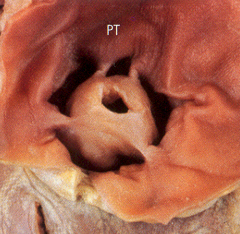
|
Unicuspid Pulmonic valve often seen in Pulmonic Stenosis/Atresia |
|
|
What does the stage II of palliative reconstruction of Fontan ciruclation for treatment of Hypoplastic Left Heart Syndrome entail? |
volume unloading of RV by making pulmonary circulation to the lungs passive (ie the RV no longer pumps to the lungs) |
|
|
A newborn baby is found to have systolic murmer. What is the cause of this murmer? |
Harmless murmer caused by the newly opened pulmonary arteries adapting to new increase in blood flow due to closure of the PDA |

